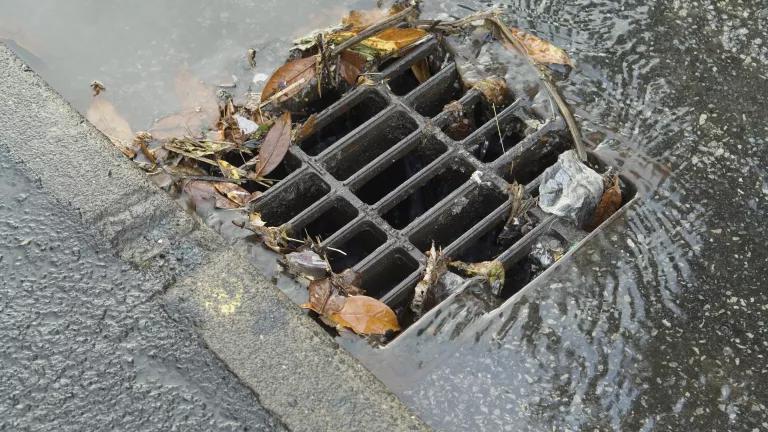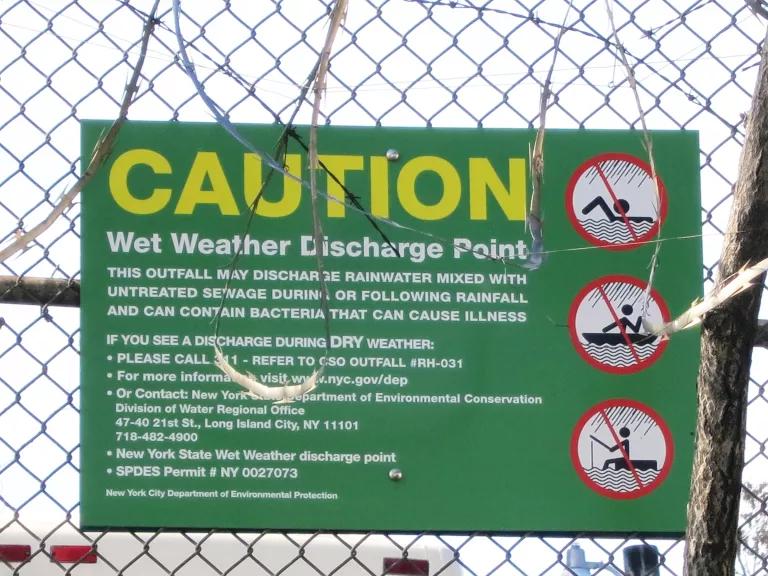When It Rains, It Pours Raw Sewage into New York City’s Waterways
The Big Apple’s combined sewer system is 150 years old—and in desperate need of improvement.

iStock
In New York City, a cleansing rain becomes anything but purifying almost as soon as it hits the ground.
Stormwater runoff—and whatever it happens to encounter on its way to the gutter—flows directly into local waterways in about a third of the city. Think about the kinds of things lingering on New York’s streets, parking lots, and sidewalks (rat poison, cigarette butts, fertilizer, pet waste, litter, gasoline . . .), and you’ll start to get the idea of the pollutants at play.
Pretty gross, right? Just wait until we get to the other two-thirds of the city.
The Straight Poop
Across about 60 percent of the Big Apple, storm runoff and sewage (i.e., what approximately 8.5 million New Yorkers flush down their toilets) stream through the same network of pipes on their way to the city’s 14 wastewater treatment plants. This combined sewer system works well enough on dry days, but when it rains a tenth of an inch per hour or more, the added volume quickly overwhelms the 150-year-old network. When this happens, “relief structures” allow a gruesome mixture of polluted urban runoff and raw sewage to bypass the water treatment plants and discharge directly into local waterways at up to 460 locations throughout the five boroughs. In the words of one New Yorker: blerg.
When a combined sewer overflow (CSO), as these events are called, happens along the Bronx River, “there is a soggy, wet film of brown floating on the water surface,” says Michelle Luebke, ecology director for the Bronx River Alliance. The scatological appearance isn’t the only clue that the city’s handling of wastewater has failed. “The river has a distinct sewage smell for approximately 48 hours,” she adds.
The overflows aren’t trickles, either. Approximately 27 billion gallons of sewage and runoff make it into the Bronx River, East River, Hudson River, Harlem River, Flushing Bay, Flushing Creek, Alley Creek, Westchester Creek, Coney Island Creek, Newtown Creek, Hutchinson River, Gowanus Canal, and Jamaica Bay every year. In 2016, there were 100 days with such overflows; the 2017 count stood at 95 at the end of October.
Swimming? Fuhgeddaboudit . . .
CSOs are every bit as disgusting as they sound, but they’re also downright dangerous. New York City’s 520 miles of shoreline are the most densely populated in the country, and its residents interact with the water in ways as varied as they themselves are—from wading, swimming, and fishing to paddling and sailing. “CAUTION” signs posted near outfalls warn people to avoid the water after rainfall or snowmelt, but advisories can do only so much. “We know that people are eating fish from the river and swimming in it despite warnings,” Luebke says. Coming into contact with germ-ridden water after a CSO can expose people to bacteria, viruses, and other nasty pathogens that sicken them with hepatitis, gastroenteritis, pinkeye, meningitis, and more.

Riverkeeper
“New Yorkers should be free to enjoy their local waters without fear of illness, rash, or infection,” says Roger Reynolds, legal director of Save the Sound. Not only should New York residents have peace of mind when it comes to the waterways that course by and through their neighborhoods, but the Clean Water Act, passed 45 years ago, demands it. The landmark law calls for U.S. waters to be “fishable and swimmable.” And yet, the New York State Department of Environmental Conservation excuses straight-up poop in the water by continuing to use water quality standards that the U.S. Environmental Protection Agency hasn’t supported since 1986.
A coalition of nine environmental organizations, including NRDC, filed a lawsuit against the EPA in June 2017 for “failing to protect the health of people who swim, boat, and fish in New York City waters.” The suit calls for the agency to force the state to update its water quality standards.
It really, really doesn’t have to be this way, says Sean Dixon, a senior attorney at Riverkeeper, another plaintiff in the lawsuit. “The collective wisdom of the city’s planners and agency engineers, coupled with the expertise of the community and environmental groups, is robust enough to solve this problem.”
Going Clean
New York is hardly the country’s only old city with an outdated sewage system, but others have been more proactive in dealing with their CSO demons. Boston, for example, built the South Boston CSO Storage Tunnel to hold excess flow during storms until it can be gradually funneled back to a wastewater treatment plant. As part of its Clean Rivers Project, Washington, D.C., is currently at work on a system of similar tunnels—along with enough green infrastructure to capture runoff from nearly 500 acres of impervious land—that aims to reduce overflows by 96 percent.
A 2002 lawsuit required Toledo, Ohio, to more than double its sewage treatment capacity to end its raw sewage discharges. In 2010, the city agreed to expand its sewer system far beyond its original proposal by spending $315 million on improvements that would bring the incidence of overflows from an average of 35 times a year down to 0–4 times a year. Philadelphia, meanwhile, is banking on green infrastructure, such as rain gardens and permeable pavements, to manage its stormwater problem.
But with its population density and unique topography, “New York City, and the harbor around it, is really in a class apart,” says Dixon. “All solutions should be on the table.”
The Big Apple, however, is coming up short. Since March 2017, New York State has approved the city’s proposals for addressing CSOs in seven affected water bodies: the Bronx River, Flushing Bay, Flushing Creek, Alley Creek, Hutchinson River, Gowanus Canal, and Westchester Creek. Four of the plans don’t provide any new reductions in CSO volume at all. Of those, three rely on chlorination (basically putting bleach in the sewers) to disinfect polluted water. While swimming pools and sewage treatment plants commonly use chlorine, those are carefully controlled applications; the chemical’s safety and effectiveness when used in pipes that discharge directly into waterways, under current system conditions, is unproven. Chlorine can be toxic to aquatic life, and Dixon says he worries about the effect residual levels of the chemical could have on wildlife. The fourth plan, for the Bronx River, simply redirects some of the foul discharge to the East River. In other places where the city is planning large CSO reductions, the implementation timelines are, at a minimum, nearly two decades long.
Though New York City’s CSO program includes significant investments in green infrastructure, the city has, so far, missed its implementation goals for current green infrastructure projects and has few or no projects planned for many of the areas suffering from overflows.
Adding it all up, the city’s approach will continue to allow hundreds of millions—even billions—of gallons of overflows to enter each water body on an annual basis. Larry Levine, a senior attorney in NRDC’s Water program, sums up the city’s proposals succinctly: “They guarantee our waters will not meet federal health standards.”
See you in court.
This NRDC.org story is available for online republication by news media outlets or nonprofits under these conditions: The writer(s) must be credited with a byline; you must note prominently that the story was originally published by NRDC.org and link to the original; the story cannot be edited (beyond simple things such as grammar); you can’t resell the story in any form or grant republishing rights to other outlets; you can’t republish our material wholesale or automatically—you need to select stories individually; you can’t republish the photos or graphics on our site without specific permission; you should drop us a note to let us know when you’ve used one of our stories.

The Battle for Jamaica Bay
New York Is Exposing the Fashion Industry for What It Is: a Climate Nightmare
What Is Congestion Pricing?